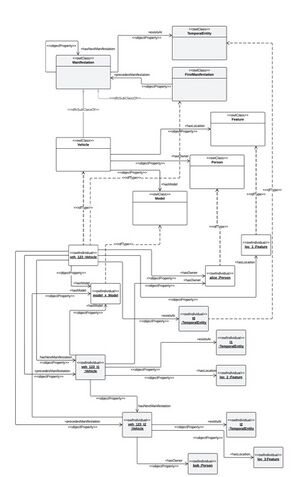Pattern:Change Pattern
Description
An English description of the definition (what distinguishes this sense of the term?).
Many of the concepts identified in the urban system ontologies are subject to change. For example, a Vehicle will have one location at one time, and another location at a later time; it can have only one passenger at one time, and four passengers at a later time. Similarly, many attributes of Persons, Households and even Transportation Networks are subject to change.
Change over time plays a role in many domains and is by no means a new research topic. In fact, several approaches for capturing change in OWL have been proposed.[10], [11] Despite these solutions, it has been found that Semantic Web practitioners currently lack clear and precise methods for how to apply these approaches to capture change at a domain level, whether reusing a temporal ontology or developing an ontology from scratch. The Change Pattern serves as a clear guide to support a consistent approach to representing change over time.
Key Concepts and Classes
The key classes and properties are formalized in Table 6 and Table 7, respectively. An approach to representing changing properties, or "fluents", that leverages the 4-dimensionalist perspective was proposed in Reference [10]. A similar approach is adopted in this document, based on the design pattern presented by Reference [12], requiring the representation of objects that are subject to change as subclasses of the Manifestation class. Manifestations may be interpreted as “snapshots” of an object at some point in time. This enables the representation of changing values of properties of an object, without losing information about its past values/relationships. The properties of the class can then be identified as properties that are (and are not) subject to change, in order to distinguish between the static and dynamic aspects of a particular entity. The Manifestation class is defined using the following properties: — existsAt: identifies the TemporalEntity that reflects the time Instant of Interval during which the snapshot of the object holds (is valid). — hasNextManifestation: identifies the immediate successor Manifestation (i.e. the subsequent snapshot of the object). — hasPreviousManifestation: identifies the immediate prior Manifestation (i.e. the prior snapshot of the object). — hasFirstManifestation: identifies the First Manifestation that is related to a particular Manifestation (i.e., for some snapshot of an object, it identifies the first such snapshot of the object). The class FirstManifestation denotes the first manifestation of an individual. No prior manifestations (in time) exist for the individual. It is a subclassOf Manifestation and contains the following additional properties: — precedesManifestation: identifies all subsequent Manifestations that follow a FirstManifestation. In other words, the FirstManifestation is related to each and every subsequent manifestation via the precedesManifestation. — hasLatestManifestation: identifies the most recent Manifestation that is related to a particular FirstManifestation (i.e., for some snapshot of an object, it identifies the most recent snapshot of the object).
Has Class(es)
Manifestation, FirstManifestation
Status
Pending Approval
Supplementary Figures
| Figure | Caption |
|---|---|
